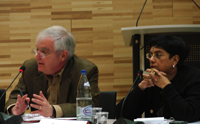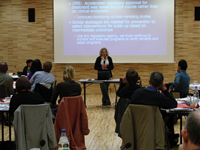Across the world, a small but growing number of countries have reduced HIV prevalence through sound prevention efforts. However, in 2006, there were still 4.3 million new HIV infections with over 40% of new adult infections occurring among young people aged 15-24. According to latest estimates, HIV prevention services reach only one in ten of people most at risk.
In an era where the world has committed to working towards universal access to HIV prevention, treatment, care and support by 2010, there is a clear and urgent need to intensify HIV prevention to halt growing infection rates and sustain the gains that have already been made in the AIDS response.
 The UNAIDS HIV Prevention Reference
The UNAIDS HIV Prevention Reference
Group met in Geneva in April 2007The call to expand high quality comprehensive HIV prevention programmes towards the goal of achieving universal access to prevention, treatment, care and support was stressed at the recent meeting of the UNAIDS HIV Prevention Reference Group, held in Geneva at the beginning of April.
Thirty-five HIV prevention experts, from national AIDS authorities, development partners, research institutions and civil society worldwide joined to discuss ways to better support efforts taking place at the country level to increase HIV prevention programmes in size and scale. Through the discussions, the meeting underlined that guidance for countries on the definitions, core components and quality standards for HIV prevention activities is critical to future action.
 L-R: Professor Michael Merson, Director of
L-R: Professor Michael Merson, Director of
the Global Health Institute at Duke
University with Purnima Mane, UNAIDS
Director for Policy, Evidence and
Partnerships .“Countries are under pressure to achieve ambitious prevention targets and thus require clear standards for high quality prevention activities,” said Professor Michael Merson, Director of the Global Health Institute at Duke University, who chaired the Reference Group meeting.
“National and sub-national AIDS programmes need to be able to make comparisons about what works and doesn’t work; and to estimate the resources required at country, regional, and global levels to provide universal access to HIV prevention services,” he added.
To assist countries in strengthening their national HIV prevention responses the participants recommended that UNAIDS work with experts in different areas of prevention to define key activities, specify their core components and develop a framework to monitor their quality.
 The two-day meeting included break-out
The two-day meeting included break-out
group work on key HIV prevention topics.“Prevention activities have been delivered successfully and to high standards for years, and clarifying and disseminating min imum quality standards more broadly will assist countries in planning and costing realistic , scaled- up behavioural prevention programmes ,” said Purnima Mane, Director for Policy, Evidence and Partnerships at UNAIDS and co-Chair of the Prevention Reference Group. “ Small differences in definitions can make it difficult to compare the same HIV prevention activities, and to determine what works in different environments.”
 Participant Supriya Sahu, Project Director
Participant Supriya Sahu, Project Director
of the Tamil nadu State AIDS Control
Society during her intervention at the
meeting.The two-day meeting of the HIV Prevention Reference Group included presentations in plenary sessions by leading prevention experts on the challenges of defining prevention activities and their core components. A draft framework for assessing the quality of HIV prevention activities also was presented and discussed. Current practice often labels HIV prevention programmes according to single features, such as their target audience (e.g. “sex worker interventions”), objective (e.g. “empowerment interventions”), setting (e.g. “workplace interventions”) and type of activity (e.g. “mass media”), whereas participants underlined the needed nomenclature should recognize that all these features are important parts of the definition and quality standards of any programme . During interactive discussions in plenary and small groups it was emphasized that comprehensive HIV prevention programmes comprise bundles of different activities, each of which can be defined to include a set of critical elements and quality standards for planning and implementation.
 The two-day meeting of the HIV Prevention
The two-day meeting of the HIV Prevention
Reference Group included presentations in
plenary sessions by leading prevention
experts on the challenges of defining
prevention activities and their core
componentsThe meeting of the UNAIDS HIV Prevention Reference Group forms part of the ongoing efforts of UNAIDS to support countries to strengthen their national responses to the epidemic. In 2005 UNAIDS published the UNAIDS Policy Position Paper for Intensifying HIV Prevention that outlined the key principles and policy actions for HIV prevention. UNAIDS recently published the UNAIDS Practical Guidelines for Intensifying HIV Prevention which provides countries with practical guidance on the activities that should be undertaken in different epidemic settings to strengthen their national HIV prevention responses within the ambit of Universal Access. The Reference Group meeting initiated a process to define and outline the quality standards and costs for the recommended set of HIV prevention activities outlined in the Practical Guidelines.
 UNAIDS Executive Director Dr
UNAIDS Executive Director Dr
Peter Piot attended the last day
of the meeting.The UNAIDS HIV Prevention Reference Group was established by the Executive Director in 2004 as a forum that brings together leading prevention experts to advise UNAIDS on approaches to strengthen and sustain HIV prevention interventions at the country and regional level. Recognizing that there are many facets to HIV prevention , each meeting of the Reference Group draws upon national AIDS authorities, civil society and scientists based upon their knowledge, expertise and experience in addressing the subject of the meeting.
All photo credits: UNAIDS/S. Imbers








